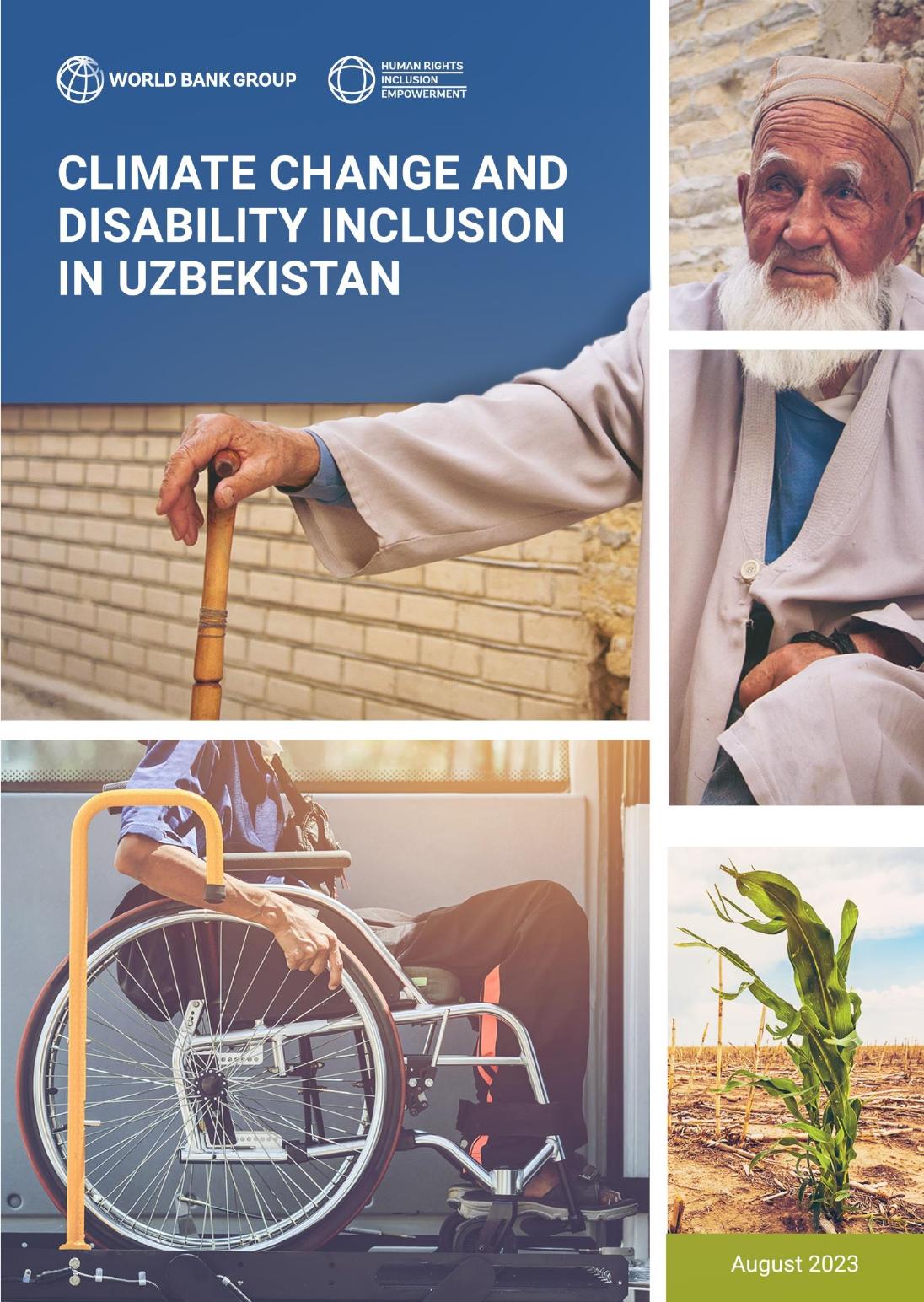PublicDisclosureAuthorizedPublicDisclosureAuthorizedPublicDisclosureAuthorizedPublicDisclosureAuthorized©2023TheInternationalBankforReconstructionandDevelopment/TheWorldBank1818HStreetNWWashington,D.C.20433Telephone:202-473-1000Internet:www.worldbank.orgThisworkisaproductofthestaffofTheWorldBankwithexternalcontributions.Thefindings,interpretations,andconclusionsexpressedinthisworkdonotnecessarilyreflecttheviewsofTheWorldBank,itsBoardofExecutiveDirectors,orthegovernmentstheyrepresent.TheWorldBankdoesnotguaranteetheaccuracyofthedataincludedinthiswork.Theboundaries,colors,denominations,andotherinformationshownonanymapinthisworkdonotimplyanyjudgmentonthepartofTheWorldBankconcerningthelegalstatusofanyterritoryortheendorsementoracceptanceofsuchboundaries.RightsandPermissionsThematerialinthisworkissubjecttocopyright.BecauseTheWorldBankencouragesdisseminationofitsknowledge,thisworkmaybereproduced,inwholeorinpart,fornoncommercialpurposesaslongasfullattributiontothisworkisgiven.Anyqueriesonrightsandlicenses,includingsubsidiaryrights,shouldbeaddressedtoWorldBankPublications,TheWorldBankGroup,1818HStreetNW,Washington,DC20433,USA;fax:202-522-2625;e-mail:pubrights@worldbank.org.Coverphoto:©Sun_Shine/Shutterstock;©ScottBook/Shutterstock;©SKTStudio/ShutterstockCoverphotodesign:CybilMarzada2TableofContentsAcknowledgements.........................................................................................................................4ExecutiveSummary........................................................................................................................5Introduction.....................................................................................................................................9DisabilityInclusionandClimateChangeAdaptation..................................................................10ResearchDesign............................................................................................................................11ClimateChangeThreatstoPersonswithDisabilities...................................................................12SocialandPoliticalExclusion..................................................................................................12AccessingEssentialHealthServices........................................................................................15SocialProtectionandtheEnumerationofPersonswithDisabilities........................................17DiscriminationintheLaborMarket.........................................................................................19DisasterManagement................................................................................................................20AwarenessofClimateChange..................................................................................................22Dignity......................................................................................................................................23PolicyRecommendations..............................................................................................................24PromoteSocialandPoliticalInclusion.....................................................................................24StrengthentheSocialProtectionandEnumerationofPersonswithDisabilities.....................26ImproveAccesstotheLaborMarket........................................................................................26ImproveDisability-InclusiveDisasterManagement................................................................27BuildAwarenessofClimateChange........................................................................................27References.....................................................................................................................................29PersonswithDisabilitiesQuestionnaire.......................................................................................34InterviewQuestionnaireforOrganizationStaffMembers...........................................................373AcknowledgementsThisreportwasauthoredbyAdamAuerbach,AudreySacks,andDilmuradYusupovwiththeSocialSustainabilityandInclusionGlobalPractice,EuropeandCentralAsiaRegion,WorldBankunderthesupervisionofVaralakshmiVemuru(PracticeManager).TheauthorsacknowledgethesupportfromHumanRights,Inclusion,andEmpowermentUmbrellaTrustFund(HRIE).TheteamthankstheRuralInfrastructureDevelopmentProjectImplementationUnitforguidanceonthefieldworkanddatacollection.AbdulloAbdukhalilov,AzizAbdullayev,SofiyaAkramova,andUlugbekMamatkanovprovidedoutstandingresearchassistanceandincisivesuggestionsonthequestionnaires.MaftunaAmanova,KhilolaDushamova,andIrodaShorakhmedovaprovidedexcellenttranslationwork.TheauthorsthankCharlotteMcClain-Nhlapo,AnnetteOmolo,DeeptiRaja,RanoTlepova,AyeshaVawda,VaralakshmiVemuru,andRobertWrobelfortheirexcellentsuggestionsonthisreport.4ExecutiveSummaryTheimpactsofclimatechangewillbeunevenlyfeltwithinandacrosscountriespartlyduetosocialandeconomicinequalities.Personswithdisabilitiesrepresent16percentoftheglobalpopulationandfacewidespreadformsofsocialandeconomicmarginalizationyethavereceivedlittleattentioninpriorstudiesofclimatechangeandsocialinequality.Themortalityrateofpersonswithdisabilitiesinnaturaldisastersis“uptofourtimeshigherthanpeoplewithoutdisabilities”(SteinandStein2021).Howdothefast-movingshocks—flooding,drought,heatwaves—andslower-movingsocialandeconomiceffectsofclimatechangeimpactpersonswithdisabilities?Howcanclimatechangeadaptationeffortsbedisabilityinclusive?ThisstudyexaminesthesequestionsthroughoriginalfieldworkandqualitativeinterviewsconductedinUzbekistan.InNovember2022,theauthorsinterviewedpersonswithdisabilitiesinthreeregionsofthecountry.Followingthisfieldwork,ateamoffourexpertinterviewers—themselvesUzbekistan-basedpersonswithdisabilities—interviewed40staffmembersof15disabilityrightsorganizationsacrossthecountry.Theresultingqualitativedataaffordkeyinsightsintohowclimatechangeanddisabilitystatusinteracttogeneratedistinctvulnerabilities.Withinthenascentfieldofclimatechangeanddisabilitystudies,thisreportrepresentsoneofthefirstfieldwork-basedaccountsofhowclimatechangepresentsheightenedriskstopersonswithdisabilitiesinadevelopingcountrycontext.Thereportoutlinesseveralimportantfindingsorganizedalongseventhemes.i.SocialandPoliticalExclusion.PersonswithdisabilitiesinUzbekistanarestrikinglyexcludedfromlocalsocialandpoliticallife,placingthematgreaterrisktoclimatechangeeventsduetotheirlackofvoiceindecisionmakingandpolicydiscussionsandsmallersocialnetworks.ii.AccessingEssentialHealthServices.Respondentshighlightchallengesinaccessingessentialhealthservicesandequipment,suchasmedicalassessments,assistivedevices,andhealthfacilities.Thesechallengesarelikelytobeevengreaterintheaftermathofclimate-induceddisasterswhentherecanbeanincreaseinthedemandfor—andmorelogisticalchallengesassociatedwith—accessingsocialandmedicalassistance.Barrierstoaccessingpublicservicesandhealthcaredeepenrisksamongpersonswithdisabilities.iii.PensionsandtheEnumerationofPersonswithDisabilities.Respondentspointedtohurdlesinaccessingpensionsandstatedthattheywereinsufficienttocoverbasiccosts.Further,thelackofreliableestimatesofthenumberofpersonswithvariousdisabilitiesimpedesthegovernment’sabilitytocraftdisability-inclusivesocialassistancepolicies.iv.DiscriminationintheLaborMarket.Respondentsdescribedpervasiveformsofdiscriminationagainstpersonswithdisabilitiesinthelabormarket,furtherintensifyingeconomicprecarityinthefaceofclimatechange.v.DisasterManagement.Fieldobservationsandinterviewshighlightseveralareasofdisastermanagementthatrequiregreaterinclusivityforpersonswithdisabilities,5includingtheneedforemergencycommunicationssystemstobeaccessibletopersonswhoaredeaf,hardofhearing,orblindandemergencyservicesrequiredbypersonswithdisabilities,suchasaccessibleevacuationpointsandtemporaryshelters.vi.AwarenessofClimateChange.Fewerthanhalfoftherespondentstothe2021RuralInfrastructureDevelopmentProjectsurveyofover4,000householdshadheardofclimatechange.Thisstudyalsofoundgenerallylowlevelsofawarenessofclimatechange.Whilelowlevelsofawarenessarenotuniquetopersonswithdisabilities,itaddsyetanothersourceofvulnerabilitytoapopulationthatalreadyfacesheightenedclimatechangerisks.Withoutanunderstandingofclimatechangeandthethreatsitposestowellbeing,householdsandcommunitiesarelesslikelytotakestepstoadapt.vii.Dignity.Theinterviewsandfieldworkhighlighttheimportanceofviewingdisabilityinclusion—withinclimatechangeadaptationandmorebroadly—asamatterofdignity.Severalrespondentsportrayedtheirexperiencesofnavigatingpublicspacesandinstitutionsashumiliating.Notonlywereinfrastructureandservicesinaccessible;theydescribedbusdrivers,employers,medicalstaff,andordinarycitizensastreatingthemwithdisregardanddisrespect.Othersassertedthattheydonotwanttobepassiverecipientsofcharityorpity;theydesireaformofdisabilityinclusionthatallowsthemtocarryouteverydayactivitiesonanequalbasiswithpersonswithoutdisabilities,withfullagencyanddignity.ThereportconcludesbydiscussingthepolicyimplicationsofthefindingsforclimatechangeadaptationeffortsinUzbekistanandelsewhere.TheGovernmentofUzbekistan’s(GoU)ratificationoftheConventionontheRightsofPersonswithDisabilities(CRPD)in2021wasaturningpointforthecountry’sdisabilityinclusionefforts.TherecommendationshighlightedinTable1willhelptheGoUprogressivelyrealizeitsobligationsundertheCRPD,includingArticle11,whichobligesgovernmentstoensurethatpersonswithdisabilitiesareincludedinallsocialprotectionsandsafetymechanisms.6Table1:OverviewofPolicyRecommendationsPolicyArea1:Promotethesocialandpoliticalinclusionofpersonswithdisabilities•Increasemahalla1(localgovernment)leaders’awarenessoftheimportanceofdisabilityinclusion.•Promotemahallaleaders’outreachtopersonswithdisabilitiestobolsterthelatter’sparticipationinlocalgovernanceandcommunityactivities.•Increaseeffortsandfundingtoensurethatlocalgovernmentmeetingsareheldinaccessiblespacesandformats.•Introduceadisability-inclusionpositionwithinmahallacitizenassemblies,heldbyapersonwithdisabilitiesfromwithinthecommunity.•Implementmahalla-level,disability-inclusiveclimateactionplans.PolicyArea2:Increasepersonswithdisabilities’accesstoessentialhealthservices•Ensurepersonswithdisabilities,especiallythoseinruralareas,canmoreeasilyobtainmedicalassessments,assistivedevices,anddisabilitypensions.•Expandoutreachservicestoruralvillages,facilitatetraveltodistrictandregionalcenters,andstreamlineeligibilitypaperworkandprocesses.•Trainmahallaleaders,medicalstaff,andrelevantcivilservantsonhowtohelppersonswithdisabilitiesaccesstheseservices.PolicyArea3:Increasesocialprotectionandenumerationforpersonswithdisabilities•Increasetheamountofsocialassistancechanneledtopersonswithdisabilities,takingintoaccounttheirvariousneeds(e.g.,adaptivesocialprotection).•Increasethetypesofsocialsupportavailabletopersonswithdisabilities(i.e.,unemploymentbenefitsandsocialassistanceintheaftermathofclimatedisasters).•SupporttheinclusionanduseoftheWashingtonGroupShortSetonFunctioninginupcomingpopulationcensusesandsurveys.•Increasetheavailabilityanduseofdisability-disaggregatedadministrativedata,includingbytheMinistryofEmergencySituations.PolicyArea4:Improveaccesstothelabormarket•Raisetheawarenessofpersonswithdisabilitiesregardingtheirlaborrightsbypublishingaccessibleguidelines,inpartnershipwithorganizationsofpersonswithdisabilities.•StrengthentheaccessibilityoftheMinistryofEmployment’sgrievanceredressmechanismforreceivingandrespondingtocomplaintsofdiscriminationintheworkplace,includingwithintheinformalsector.•Raiseemployers’awarenessofstateincentives(taxbenefits,micro-credit,subsidiesforadaptingworkplaces)toimprovedisabilityinclusiveness.•Raiseawarenessoftheillegalityofdiscriminationbasedondisabilitywhenrecruitingoremployingpersonswithdisabilities.•Introduceadministrativeliabilityinthenationallegislationondisabilitydiscriminationinemploymentanddevelopsanctionsfornon-compliantemployers.PolicyArea5:Establishdisability-inclusivedisastermanagementsystems1Mahallasarethelowesttierofterritorialorganization.7•Establishdisability-inclusiveguidelinesforpreparingandrespondingtodisasters,whichincludeemergencyhotlines,evacuationpoints,andtemporaryaccommodationaswellasmedicalequipmentandmedicine.•TraintheMinistryofEmergencySituationsstaffontheCRPD’sdisabilityrights-basedapproachanddisability-inclusivepreparednessandresponse.•Trainandsupportcommunity-levelfocalpointstosupportpersonswithdisabilitieswithreachingsafetyandaccessingemergencyservices.PolicyArea6:Raiseawarenessofclimatechange•Organizedisability-inclusivepublicawarenesscampaignsonthesourcesandconsequencesofclimatechangeandwaystoadapt.Thesecampaignsshouldunderscoretheheightenedrisksofclimatechangetopersonswithdisabilities.•Trainmahallaspecialistsonclimatechangeto(a)improvetheireffectivenessinraisingawarenessofclimatechangeandadaptationstrategies;(b)informlocalgovernmentplanningandinvestments;and(c)targetresourcestovulnerablegroups,includingpersonswithdisabilities.PolicyArea7:Fosterdignity•TrainallfrontlineserviceprovidersandmahallaleadersintheCRPD’sdisabilityrights-basedapproach.•ImplementArticle11oftheCRPD,whichobligesgovernmentstoensurethatpersonswithdisabilitiesareincludedinallprotectionandsafetymechanisms.•Userights-based,disability-inclusivelanguagewhenaddressingpersonswithdisabilitiesandtheirneeds.8IntroductionInApril2022,devastatingmudslidesleveledhouses,damagedinfrastructure,andkilledseveralpeopleinaclusterofvillagesinJizzakhProvince,Uzbekistan.Thesedisastersoccurredagainstthebackdropofalarmingclimatechangeprojectionsforthecountry,includingrisingtemperaturesandintensifyingdrought,flooding,andwildfires(WorldBank2021a).Shahzod,aresidentofJizzakh,describedthedamageandexplainedthechallengeshewouldfaceifheneededtoevacuatehishomeduringafuturemudslide,givenhisphysicaldisability.Hereliesonamakeshiftplasticcane,andcanonlymoveaboutthevillage’srugged,unpavedstreetswithassistanceandcaution.Heexplained:Aftertherecentmudslide,Iwashospitalizedforaboutaweek…Iamanxiousaboutwhatwillhappeninthefuture...Icannotescapewithoutspecialequipment.2Nosir,200kilometersawayinTashkentcity,highlightedadifferentexperienceandconcernrelatedtoclimatechange.Nosirisdeaf.Heexplainedthatthedeafcommunityfacessignificantdiscriminationinthecity’slabormarket.OneinformaljobthatNosirandothermenwhoaredeafhavetakeninTashkentisparkingattendant—guidingcarsintoparkingspotsandwatchingthemwhiletheirpassengersareshopping,eating,orconductingotherbusinessinthearea.Inadditiontofacingroutineformsofdisdainanddisrespect,Nosirexplainedthehealthrisksofhavingtostandoutsidealldayduringthesummermonths,whichincreasinglyfeatureblisteringheatwaves.Duringheatwavesweworkintheparkinglotuntillunchtimeduetounbearableheat.Wecannotworkafterlunchasitgetsveryhot;ourhandsburn,anditaffectsourskin.Wecangoinifthereisshade,buttherearefewtreesinTashkentnow.Duringsuchheatwaves,weusuallydon’tstandoutside;nooneworksattheparkinglot.Ourincomeisusuallylowerduringthisseason,andwemusteatonlybreadproducts;wesurviveonlythankstoourlimiteddisabilitypension.3Areclimatechangeadaptationeffortsinclusiveofpersonswithdisabilities?Although16percentoftheworld’spopulationhassomeformofdisability(WHO2023),anemergingliteraturedemonstratesthatclimatechangeadaptationeffortsdonotadequatelyaddresstheneedsofpersonswithdisabilities(Gaskinetal.2017;Jodoinetal.2020).Yetthispopulationfacesheightenedthreatsfromclimatechange(WorldBank2018).Reflectingtheseheightenedthreats,themortalityrateofpersonswithdisabilitiesinnaturaldisastersis“uptofourtimeshigherthanpeoplewithoutdisabilities”(SteinandStein2021).Disability-inclusiveplanningisthusacriticalaspectofclimatechangeadaptation.ThisreportpresentsfindingsfromanoriginalqualitativestudyofclimatechangevulnerabilitiesamongpersonswithdisabilitiesinUzbekistan.InNovember2022,aresearchteamconductedfieldworkintheregionsofJizzakh,Sirdaryo,andTashkent.Thisfieldworkincludedinterviewswithnearlytwodozenpersonswithdisabilitiesacrosssixvillagesand2InterviewwithShahzod,November2022.3InterviewwithNosir,November2022.9severalurbanneighborhoods.AteamoffourexpertinterviewersinvolvedinUzbekistan’sdisabilityrightsspacetheninterviewed40staffmembersfrom15disabilityrightsorganizationsacrossthecountry.Theseorganizationscoveravarietyofdisabilities,providingkeyinsightsintothestateofdisabilityinclusioninUzbekistanandtheclimate-change-relatedthreatstopersonswithdisabilities.Thereportproceedsasfollows.Itfirstsituatesthestudywithintheliteraturesondisabilityrightsandthesocialimpactsofclimatechangeandmotivatestheneedtoexaminetheintersectionofthesetworesearchareas.Itthendescribesthequalitativeresearchdesignandoutlinesthefindingsofthefieldworkandinterviews.ThereportconcludesbydiscussingthepolicyimplicationsofthefindingsforclimatechangeadaptationinUzbekistanandelsewhere.DisabilityInclusionandClimateChangeAdaptationTheimpactsofclimatechangeare,andwillcontinuetobe,unevenlyfeltwithinandacrosscountriesdueinparttosocialandeconomicinequalities(Harlanetal.2015;IslamandWinkel2017).Priorresearchhasdemonstratedhowwomen’seconomicandpoliticalmarginalizationoftenmakesthemmorevulnerabletotheadverseimpactsofclimatechangethanmen(Denton2002;Abebe2014;Perezetal.2015).Otherstudieshaverevealedhowstructuralracismplacesdisproportionateburdensfromclimatechangeondisadvantagedethnicandracialgroups.IntheUnitedStates,socialandrace-baseddiscriminationhaspowerfullyshapedeventssuchasthewatercrisisinFlint,Michigan(Meehanetal.2020).PersonsofcolorinUScitiesarealsoexposedtourban“heatislands”morethanothersocialgroups(Hsuetal.2021).Economicinequalitiesfurthershapeexposuretotherisksofclimatechange.Sedovaetal.(2020),forinstance,documenthowpoorfarmersinIndiafacegreaterstrugglesinrecoveringfromweathershocksthantheirhigher-incomeneighbors.Likewise,low-incomemigrantsinIndia’scities,whooftenfacedismissivebureaucraciesandrelyoninformalhousingandemployment,aremorevulnerabletoclimatechangethanpropertied,long-timeresidents(ChuandMichael2019).Over1billionpeople,orabout16percentoftheglobalpopulation,havesomeformofdisability.Thisnumberhasincreasedduetoageingpopulationsandasurgeinchronicillnessessuchasdiabetes,heartdiseases,cancer,andmentalhealthdisorders(WHOandWorldBank2011).Thevastmajority(80percent)ofpersonswithdisabilitiesliveinlow-andmiddle-incomecountries(WHOandWorldBank2011).The2030AgendaforSustainableDevelopmenthighlightstheneedsofpersonswithdisabilities(UN2015b).Personswithdisabilitiesallovertheworldfacewidespreaddiscriminationandlacksufficientaccesstotheirphysicalenvironment.Anascentliteratureexplorestheheightenedthreatsofclimatechangetopersonswithdisabilities.Inareviewofstudiesonthetopic,Gaskinetal.(2017)findthatpersonswithdisabilitiesfaceincreasedvulnerabilitiesduetotheirexclusionfromadaptationplanningandimplementation.Jodoinetal.(2020)outlinea“disabilityrightsapproach”toclimatechangeadaptationandadvocatemainstreamingtherecommendationsoftheConventionontheRightsofPersonswithDisabilities(CRPD)withinglobalclimategovernance.Gartrelletal.(2022)examinehowwomenwithdisabilitiesinCambodiafaceintersectionalvulnerabilitiesduringdisasters.Thisemergingliteratureconcentratesmostlyonpolicydiscussionsandcriticalengagementswithinternationallaw.EmpiricalstudiespredominantlyexaminetheinteractionofdisabilityandclimatechangeintheUnitedStates,especiallyinthecontextofHurricaneKatrinain2005(Gaskinetal.2017).Thisreportadvancestheliteratureondisabilityinclusionandclimatechangethroughafieldwork-basedstudyinaGlobalSouthcontext.10Uzbekistanisanappropriatecontextinwhichtoexaminedisabilityinclusionandclimatechange(WorldBank2021a).Climatechangeisexpectedtocreatesignificantvulnerabilitiesinthecountry.Underthehighestprojectedemissionspathway(RCP8.5),bythe2090saveragetemperaturesinUzbekistanwillincreaseby4.8oC,andseveredroughtswilloccur9outofevery10years,withalarmingimplicationsforwateraccess,nutrition,andagriculturalproductivity.Flashflooding,wildfires,andmudslidesareexpectedtoincreaseinfrequencyandseverity,generatinglocalandregionaldisasterswithsubstantialhumanandeconomiccosts.ThedesertificationoftheAralSeaisexpectedtohasten,leadingtomorefrequentduststormsandthespreadofgroundcontaminantsfromearlierpesticideuseintheregion.InclusiveadaptationanddisasterriskmanagementisthereforeofcriticalimportanceinUzbekistan.ResearchDesignDatacollectiontookplaceintwostages.Inthefirststage,24semi-structured,face-to-faceinterviewswereconductedwithpersonswithdisabilitiesinJizzakh,Sirdaryo,andTashkentregionsinNovember2022.Theseinterviewsgeneratedinsightsintotheclimate-change-relatedchallengesfacedbypersonswithdisabilities.Givendifferencesinlabormarkets,localadministrativecapacity,thephysicalbuiltspace,andthereachofnon-governmentalorganizations(NGOs),theexperiencesofpersonswithdisabilitieslikelyvaryacrosstherural–urbandivide.Interviewswereadministeredinbothurbanandruralareas—inthecapital(Tashkent)andinvillagesinJizzakhandSirdaryo,respectively.Inthesecondstage,betweenNovemberandDecember2022,phoneinterviewswereconductedwith40representativesfrom15nationalandregionaldisabilityrightsorganizations.Theface-to-faceinterviewsaskedbroadquestionsthatallowedampleroomfornarrationandunanticipateddirections.Thisapproachwasimportantgiventheunderstudiednatureofdisabilityinclusioninclimatechangeadaptation.Therespondentsexperiencedseveraltypesofdisabilities,includingvisual,hearing,mobility/physical,anddevelopmental/intellectual.Thesampleincludedmenandwomen,providinginsightsintointersectionalformsofmarginalization.JizzakhandSirdaryowereselectedbecausetheypresentvariedtopographies,includingsnow-cappedmountainsandrollinggrasslands,affordingadegreeofvariationinlocalclimatechangevulnerabilities.ThefindingscannotbeassumedtoapplyuniformlyacrossUzbekistan’ssociallyandgeographicallydiverseregions.Forexample,JizzakhandSirdaryo,locatedintheeasternpartofthecountry,experiencedifferentclimatechangevulnerabilitiesthanthearidwesternprovinceofKarakalpakstan.Yetthefindingsfromthe40interviewswithstaffmembersofdisabilityrightsorganizationsresonatewiththoseconductedinJizzakhandSirdaryo,whichincreasesoverallconfidenceinthestudy’sconclusions.FollowingtheinterviewsinJizzakh,Sirdaryo,andTashkent,ateamoffourissueexpertsinvolvedinthecountry’sdisabilityrightsmovement—themselvespersonswithdisabilities—wasconvenedtoadviseonquestionnairedesignandsamplingandtheninterviewstaffmembersfrom15nationalandregionaldisabilityrightsorganizations.Theseorganizationsprovideservicestopersonswithawiderangeofdisabilities(visual,hearing,physical,developmental/intellectual,andpersonswithHIV/AIDS).Thisvariationingeographyandsubstantivefocusaffordsrichinsightsintothestateofdisabilityinclusionandexposuretoclimatechangethreatsamongpersonswithdisabilities.Interviewswereaudiorecorded,transcribed,andtranslatedintoEnglish.11ClimateChangeThreatstoPersonswithDisabilitiesTheinterviewsandfieldworkgeneratedarichsetofqualitativedata.Thefindingsareorganizedintosevenbroadthemesillustratedusingquotesfromtheinterviews:socialandpoliticalexclusion,navigatingthestateforessentialservices,pensionsandsalaries,discriminationinthelabormarket,disastermanagement,awarenessofclimatechange,anddignity.Thesethemesincludeindirectareasofvulnerability—formsofeverydaysocialandpoliticalmarginalizationthatintersectwithclimatechangetodeepentherisksfacingpersonswithdisabilities—aswellasthosethataremoredirect,includingformsofexclusionwithindisasterresponsesystems.SocialandPoliticalExclusionThepersonswithdisabilitiesinterviewedforthisstudywerestrikinglyexcludedfromsociallife.Mostrespondents,especiallyinJizzakhandSirdaryo,werehouseboundduetoacombinationofsocialdiscrimination,alackofassistivedevices,andinaccessiblepublicinfrastructure.Assuch,theyhadlimitedsocialengagementwithpeopleoutsideoftheirhousehold.Forexample,onemaninaremotevillageinSirdaryohadbeenparalyzedinacaraccident.Heexpressedaneagernesstovisitotherareasofthevillagetosocialize,buttheunpavedroadshadalreadydamagedseveralwheelchairs.Movementinpublicwasjusttoocumbersomeandrisky.Whileheaspiredtoworkfromhomeasacellphonerepairperson,itwasdifficulttostartthebusinesswithoutbeingabletovisitpotentialcustomers.AnotherrespondentinamountainousvillageofJizzakhinjuredherlegsandspineinafall.Formonthsshehadbeenunabletoleaveamattressonthefloor,saveafewvisitstoadoctor,whohasbeenunabletoprovidetreatment.Worriesaboutherphysicalhealthwerecompoundedbymountingdistressaboutsocialisolation.Theinterviewswithstaffmembers,mostofwhomexperiencesomeformofdisability,echoedfeelingsofisolation:Interviewer:Dopeoplewithdisabilitiesparticipateinthelifeoftheneighborhood?Respondent:No,no,no,no.Interviewer:Therearethosewhoareinvolvedinneighborhoodlife,right?Respondent:Therearesomebutnotmany.4Asnotedabove,socialexclusionispartiallytheresultofinaccessiblepublictransportation,publicbuildings,andspaceswherepeoplegathertosocializeandseekentertainment.Thisthemefrequentlyemergedacrosstheinterviews:Thereareveryfewbuseswithramps;Iwouldn’tbewrongifIsaid5percentor1percent.5IcansaythatthisisasadandpainfulpointinNamanganregion…almostallthesmallIsuzubusesrunningontheroadroutesofNamanganregiondonothaveanycomfortoropportunityfordisabledpeopletomovefreely...64InterviewwithRespondent1.5InterviewwithRespondent1.12Inmanyplaces…therearerampsinpublicbuildings,buttheydonotmeetthestandard.Afterthat,youwillgoinside,insidethebarrierwillopenforyou,butitisdifficulttogettothe3rdfloor.7Busstopsarenotonlyinaccessibleforpersonswithdisabilities,butalsoinaccessibletoordinarypeople.Sometimesyoumustgodownfromthesidewalkandwalkalongtheroadway.Thisisacompletedisgrace.8Theunsuitabilityoftransport,especiallythemetro,thepoorattitudeofdriverstowardpassengerswithdisabilities,allofthisisabarrier…becausethetransportsystemisnotadapted[forpersonswithdisabilities],theyaredeprivedoftheopportunitytostudyandwork.9Thesocialexclusionofpersonswithdisabilitiesgeneratesincreasedrisksinthecontextofclimatechange.Studiespointtothekeyroleofsocialcapitalinpre-disasterpreparednessandpost-disasterrecovery(Woolcock2010).DrawingoncasestudiesofHurricaneKatrina,the2004IndianOceantsunami,andthe1995KobeearthquakeinJapan,Aldrich(2012)showshowcommunitieswithdensesocialnetworksarebetterabletorebuildfollowingdisasters.Densesocialtieshelppeoplehandleshocks,especiallyamonghouseholdsfacingeconomicprecarity(Krishna2010),becausetheyfacilitatemutualaidandconsumptionsmoothing(RosenzweigandStark1989;FafchampsandLund2003;Ambrusetal.2014).Socialtiesoutsidethehouseholdfurtherunderpintheabilityofindividualsandgroupstomobilizetosecurepublicgoodsandservices(Krishna2002;Kruks-Wisner2018;Auerbach2020).Theroleofsocialcapitalindevelopmenthasgenderdimensionsaswell.Multiplestudieshighlightthepivotalroleofsocialtiesamongwomeninincreasingintrahouseholdbargainingpowerandpoliticalparticipation(Sanyal2009;Prillaman2023;Anukritietal.2022).Researchinpost-disastersettingsalsoindicatesthatwomenmayaccessservicesindifferentwaysthanmen(forinstance,byrelyingmoreheavilyonformalstateactorsandinstitutions),whichmayrequirecollectiveaction(Kruks-Wisner2011).Theseclusionofmanyofthefemalerespondentsunderminestheirabilitytodrawonsocialtiestoboostdecision-makingagencyathomeortoparticipateinthepublicsphere,generatingintersectionalsourcesofvulnerabilityinthefaceofclimatechange.Constrainedsocialnetworksalsosloworstopthespreadofinformation.Theprovisionofnewinformationcanencouragebehavioralchangeandtheadoptionofnewtechnologies(ConleyandUdry2010;Allcott2011;Zilbermanetal.2012;Banerjeeetal.2013).Thesocialisolationdescribedbymanyrespondentscaninhibittheiraccesstoinformationaboutclimatechangeandadaptivemeasures,deepeningtheirvulnerability.6InterviewwithRespondent2.7InterviewwithRespondent3.8InterviewwithRespondent4.9InterviewwithRespondent6.13Ourblindpeople,whomostlystayathome,areseparatedfromsociety,anddonotparticipateintheeventsorganizedbysociety;[they]usuallyremainunawareofsuchinformation[aboutclimatechange].10Personswithdisabilitiesarealsoexcludedfrompublicparticipation.MostrespondentsinJizzakhandSirdaryodidnotattendlocalgovernmentmeetings.Onerespondent’srelativetoldus,“He[amanwithaphysicaldisability]can’tparticipateinthemahalla11meetingsbecausehecan’twait,can’tsit.”Thislackofparticipationpartlystemsfromthebuiltspace:theruralmahallabuildingstheteamvisitedhadsteepstaircaseswithnorailingsorrampsandwerethusinaccessibletopersonswithphysicaldisabilities.Manystudyrespondentswouldrequiresubstantialassistancetoentertheirlocalmahallacenter.Andforpersonswithdisabilitieswhocantraveltoandenterthebuilding,theremightnotbenecessaryservices—suchassignlanguageinterpreters—toallowthemtoengageindiscussionswithofficialsandresidents.TheRuralInfrastructuralDevelopmentSurvey(RIDP)—administeredin2021to4,000householdsin100villagesacrossfiveregionsofUzbekistan—revealedthatpersonswithdisabilitieshaverelativelylowlevelsofparticipationandperceptionsofinfluenceinlocaldecisionmaking.Respondentscommentedonthemarginalizationofpersonswithdisabilitiesinlocalgovernance,andseveralsuggestedtheneedforinstitutionalizedmeasureslikehiringcivilservantsandfrontlineserviceproviderswithdisabilitiestosupporttheirfullinclusion:Itisdifficulttogetinformationfromthemahalla;itisbasicallyclosed,andevenifIoffermyservicesasadisabledperson,theysay,‘We’llthinkaboutit,’andthat’sit.Theytrynottoletmeintothemahalla’saffairs…Ithinkinourmahallathereshouldbeatleastoneemployeewithdisabilities,becausewhenthispersonhasexperience,heknowshowtosolvetheproblemsofpeoplewithdisabilities.12Peoplewithdisabilitiescannotbeincludedinneighborhoods.Stateprogramshavebeenissuedfortheinclusion[ofpersonswithdisabilities],andtheconventionondisabledpeoplehasbeenadopted.They[governmentofficials]don’tevenhave1percentunderstandinginthisfield.Forthat,theyneedtobetrainedandretrained...13Nooneiscallingthem;thedeaf-mutes[sic]arebeingignoredfornow.Theydonot[participate]inthemahallas.14Thestaffmembersinterviewedforthestudyobservedthatpersonswithdisabilitiesanddisabilityrightsorganizationsremainsidelinedfrompolicydiscussionsatmultiplelevelsofgovernment.Theseconversationshighlightedademandforgreaterrepresentationingovernmentinstitutionsandpolicydiscussions:10InterviewwithRespondent7.11Mahallasarethelowesttierofterritorialorganization.SeeUrinboyevandEraliev(2022)onformalmahallainstitutionsaswellastheinformalhistoriesofthesecommunityorganizations.12InterviewwithRespondent8.13InterviewwithRespondent9.14InterviewwithRespondent10.14TheCouncilsofPeople’sDeputiesareheldinregionsanddistricts,butourorganizationsarenotinvitedtothemeetings.Personswithdisabilitiesarealsonotinvitedtothesessions…In2022,aprogramwasformedtofurthersupportpersonswithdisabilities…noorganizationsthatworkwithdisabledpeoplewereinvited.15Idon’tknowapersonwithadisabilitywhohasbeenamemberofthelocalauthority;notonlydeputies,butofthemahallaauthority.So,Idon’tthinkthey[personswithdisabilities]haveanyinvolvement[inlocalgovernance].16Let…peoplewithdisabilitiesintotheirranks[thegovernment],sothattheyalsocanparticipate…sothattheycouldshowhowvulnerabletheyare,fromthepointofviewofapersonwithadisability...17Publicparticipationisanimportantaspectofclimatechangeadaptation(Ayers2011;Arnoldetal.2014;Sarzynski2015).Alargeliteraturedemonstratesthepivotalrolethatcitizenparticipationcanhaveinimprovinglocaldevelopmentprojects(seeMansuriandRao2013).Inthecontextofclimatechange,suchparticipationallowsofficialstoidentifylocalvulnerabilitiesandharnesscommunityknowledge,preferences,andparticipationtoadapttoclimatechangeandmitigatepotentialdisasters.Insomeinstances,communitiesmayalreadyhaveinformalorganizationstomanagecommonpoolresources,suchaswateruseassociations,andtoreduceintracommunityconflicts(Ostrom1990;Adgeretal.2005).Theseinformalinstitutionsandlocalcivilsociety,inpartnershipwiththestate,canhelp“co-produce”importantpublicgoods(Ostrom1996).Thedisabilitystudiesfieldalsohighlightstheneedtoinvolvepersonswithdisabilitiesingovernanceactivities,capturedinthemotto“nothingaboutuswithoutus”(Charlton1998).Themarginalizedstatusofpersonswithdisabilitiesprecludestheiractiveparticipation,mutingtheirvoicesindecisionmakingrelatedtoclimatechangeadaptation.AccessingEssentialHealthServicesRespondentsdiscussedthechallengesofnavigatingstateinstitutionstosecuremedicalassessments,assistivedevices,anddisabilitypensions.Suchbarriersareespeciallyhighinruralareas,wherevillagescanbefarfromdistrictcentersandpublictransportationislimitedandofteninaccessibleforpersonswithdisabilities.18Awomanwithaspinalcordinjurytoldus,“Wewenttothelocalgovernmentseveraltimes,butpeopledidnotdoone-thirdofwhatourpresidentdeclared.Themayordidnothelpatall,andneitherdidtheregionalprosecutor.”Manyintervieweesexpressedsuchfeelingsoffrustrationanddespondency:15InterviewwithRespondent11.16InterviewRespondent12.17InterviewwithRespondent13.18InterviewwithRespondent14.15Imagineablindpersongoingtoaclinic…Ididnotseeanyoneattheclinictrainedtodealwiththeblind…thereisnoBrailleaboutadmissiondays.Orthereisnoequipmenttoprovidevoiceinformation.Suchthingsdon’texist…19Irecentlyhadhealthproblems;theytookmetothehospitalinanambulance…I’mlyingonthehospitalbed,andtheybroughtmetothesurgeryroomandthedoctorwasnotthere…Therewere6nursesgatheredandplayingsongsontheirphones,buttherewasnowordfromthedoctor…Afterbeinginthere,theyasked,‘Haveyoupaidthefee?’‘No,I’madisabledpersonofthefirstgroup,wedon’tpay,Ihaveagroupcardthatwehaven’tpaidyet.’Hekickedmeout,sayingthatIwillnotlookafteryouifyoudon’thavemoney.Theytookmefromoneendofthecorridortotheotherend,andfinallytheythrewmeoutintothecorridor.20Ourwomen,deafwomen,areashamedtogotothehospitalbecausetheycannotexplaintheirthoughts.Evenifshegoeswithatranslator…She[thetranslator]doesn’ttelleverythinguntiltheend.Shedoesn’tsaythewholething…Translatorsareacomplicatedandurgentissueforus.WehavefewtranslatorsinUzbekistan.21Hospitalsdonotcreateabarrier-freeenvironmentforpeoplewithdisabilities.First,theydonotcreatecomfort.AsimpleexampleistherehabilitationcenterinNukusdistrict,whereitisdifficultforapersoninawheelchairtoenterthetoilet.22Togettoanophthalmologist,apersonwithadisabilitymustfirstfindacompanion…Ifthereisnocompanion,thenthepersonwithadisabilitywillnotbeabletogotothedoctorintime.Thisisthefirstthing.Thesecondisfreeorders…ifyouwanttogetanorder,notjustfortreatment,butforanexam,thenyoumustgototheclinicfirst,getareferral.Getsomecertificates,thengotothedistricthealthdepartment,submitallthedocuments,andonlythencanyoubegivenanorderforanexam,forafreeexamatanyhospital…Itwouldbebetterforapersonwithadisabilitytogodirectlytotheinstitution,registerasapersonwithadisability,andreceivefreeservices.23Tocalladoctortoyourhouse,youmustswearonthephone.Evenyourlocaldoctorwon’tcomeifheknowsyoucan’ttakecareofyourself…Here,wesufferatalllevels:youwon’tgettotransport;youwon’tgetintothetransport,ifyougettotheclinic,thenyouwon’tbeabletoclimbtothesecondfloorintheclinic.2419InterviewwithRespondent15.20InterviewwithRespondent1.21InterviewwithRespondent16.22InterviewwithRespondent3.23InterviewwithRespondent12.24InterviewwithRespondent17.16ThevillagesinJizzakhandSirdaryohadnolocalNGOsworkingtosupportpersonswithdisabilities;mostsuchorganizationsseemtooperateprimarilyinurbanareas.Thus,itischallengingforpersonswithdisabilitiestoaccessstateaswellasNGOservices.Astaffmemberofonedisabilityrightsorganizationpointedtothedifficultiesofaccessingmanyruralareasduetotheirremotelocationsandoftenunderdevelopedpublicroads.Weusedtogototheremoteareas;theroadsarerough…itwasaproblemforapersonwithadisabilitytogotothestoreorothernecessaryplacesforhisneeds.25Policymakersstresstheimportanceofhavingrobustsocialsafetynetsinplacetoaddressdisastersandclimatechangevulnerabilities(Daviesetal.2008;UnitedNations2015a;WorldBank2022).Asillustratedinthequotesabove,thepersonswithdisabilitiesinterviewedforthestudydescribeddauntinghurdlestoaccessingstateandnon-stateservices.Thesechallengesarelikelytobeevengreaterintheaftermathofclimate-induceddisasters,whenthereislikelybeanincreaseinthedemandfor—andmorelogisticalchallengesassociatedwithaccessing—socialandmedicalassistanceandemploymentopportunities.Thesechallengesincreasetheclimatechangeriskstopersonswithdisabilities—individualswhoalreadyfrequentlyfaceeconomicprecarityandhealthrisksduetosocialdiscriminationandinaccessiblepublicinfrastructure.Severalstaffmembersreflectedontheeconomicvulnerabilitiesfacingpersonswithdisabilities:Thesearefamiliesthathavelittleincome…Peoplewithchildrenwithdisabilitiesspendmostoftheirsalaries,opportunities,andfinancesontreatment,andtorecoverfromsomekindofnaturaldisaster,theyaremorevulnerable…26Ourpeoplelivebelowthepovertyline,ononepension.Iknewonefamilywitheightchildren.Theirfatherdiedandthemothercannotgotoworkbecauseherchildhastuberculosis.Heliesdownandshetakescareofhim.Theycan’tevengetapensionforit.Wehelpedthemandtheybegantoreceiveapension.Thewholefamily—ninepeople—livedonthispension.27SocialProtectionandtheEnumerationofPersonswithDisabilitiesSeveralintervieweesmentionedchallengeslinkedtoUzbekistan’spensionsystem.Therearedisability-specificbenefitsforchildrenandadultswithdisabilities,buttheamountandcoverageofsuchbenefitsisinsufficient.AsofApril1,2022,theminimumamountofdisabilitybenefitspaidtocitizenswithdisabilities,aswellasdisabilitypensionsforthosewhodonothaveworkexperience,was622,000soums(aboutUS$55).AccordingtoUNICEFUzbekistan(2020),thisschemecoversonly52percentofchildrenwithseveredisabilities.Basedonadministrativedata,outof484,000people,66percentreceivetheDisabilityPension,30percentreceivetheDisabilityAllowance(forthoserecognizedashavingadisabilitysincechildhood),andonly425InterviewwithRespondent11.26InterviewwithRespondent13.27InterviewwithRespondent17.17percenthaveaccesstotheDisabilitySocialPension,whichisprovidedtothosewhoacquiredadisabilityinadulthoodbutdonotcontributetothepensionfund(UNICEFUzbekistan2020:38).Mothersaged60andabovewithnoworkexperienceandwhosechildrenhavedisabilitiessincechildhoodareeligibleforanold-agebenefit.DuringtheCOVID-19pandemic,theGovernmentofUzbekistan(GoU)introduced‘ironnotebooks’(temirdaftar)toidentifysociallyvulnerablegroupsinneedofsocialsupport;28notebookshavesincebeencreatedforwomenandyouth.Respondentspointedtohurdlesinaccessingpensionsaswellastheirinabilitytomeetbasicneeds:Today,ourgovernmenthasaminimumpensionamount.Butwearenotsatisfiedwithit.29Disabledpeoplereceiveapensionof700,000soums…700,000soumsisnothing…Theyarespendingthatmoneyonelectricityandgas.Theycan’tpayfortheirelectricityandgas.Thegovernmentturnsitofffornonpayment...Noonelistenstouswhenwegotothepowerplant.30Unfortunately,blindpeopleareleftoutoftheseyouthandwomen’sregisters.Itisnottransparent.31Whenwereceivedthelistoftheyouthregister,manyofouryoungpeople[withdisabilities]werenotincluded.Youngpeoplearenotabletofullyusethenotebooks.Notallwomenareincludedinthewomen’sregister.Itturnedoutthatmanywomenwhostudiedatourcenterwerenotincludedinthewomen’sregister...32Theauthoritiesdismissdisabledpeopleinmanyways.‘Deafmutes’arebeingleftout…Itisverydifficultformetogetasubsidyforthem.Sometimesthey[officials]saythattheyreachedthelimit,sometimestheysaythatthepersonisregisteredinanironnotebook,sometimestheyreturnfromtheregisterfromanotherplace.33Icantellyouhowdisabledpeopleareassessedinmahallaswhentheyneedsomekindofmaterialassistanceorapension.So,theyrefusefinancialassistancetothosedisabledpeoplewhohaveaTVandarefrigeratorathome.Canyouimagine?HowcanhavingaTVandarefrigeratorcauseadenialoffinancialassistance?3428The“ironnotebooks”containlistsoflow-incomehouseholdsthatareeligibleforsocialwelfareprograms.29InterviewwithRespondent18.30InterviewwithRespondent10.31InterviewwithRespondent19.32InterviewwithRespondent20.33InterviewwithRespondent10.34InterviewwithRespondent6.18Respondentsalsofrequentlymentionedthattheymustchoosebetweenpensionsystems,forexamplebetweenaretirementpensionandadisabilitypension.Whereotherpensionsaremoregenerous,respondentsdidnotpursueadisabilitypension—whichmaycontributetoundercountingthenumberofpersonswithdisabilities.WhiletheGoUestimatesthat2.1percentofthepopulationhassomeformofdisability(WorldBank2021b),aWorldBankstudyfoundthatthepercentageissubstantiallyhigher,ataround13.5percent(UNICEFUzbekistan2019,p.11).Withoutreliableestimatesofthenumberofpersonswithvariousdisabilities,governmentshavelessinformationwithwhichtocraftdisability-inclusivepolicies.Themostimportantthingistokeepanaccuraterecordofpeoplewithdisabilities,includingwhethertheyaresingleornotandhowmanypeoplewithdisabilitiesareinthefamily,sothatduringanemergencytheycanbethefirstto[get]help.35Thereareverybigproblemswiththeevacuationofdisabledpeople,peoplewithlimitedabilities.Inourcountry,thestateandmanyagenciesandministries,theyarenotinformedinwhichflat,inwhichhouse,orinwhichareaapersonwithdisabilitieslives…Whenthesedisasterscome,theywillnotcometohelpandthepersonwithdisabilitiesisleftwithoutprotectionandmustrelyonthemselves.36DiscriminationintheLaborMarketPersonswithdisabilitiesexperiencewidespreaddiscriminationinthejobmarket.Oneorganizationstaffmember,whoisblind,notedthatpersonswithdisabilitiesfacebarrierstofindingjobsbecausetheyare“consideredtheweakpointsinsociety.”37Astaffmemberinarelatedorganizationconcurred:“Today,moreandmoreofouryouthwithlimitedopportunitiesarestudying,graduatingfromuniversity,and[some]findtheirway,toacertainextent,aftergraduation.Butmoststayhome.”38Anotherrespondentreported,“businessmanagersareafraidtohirethem[personswithdisabilities].”39Feelingsofbeingtreateddismissivelybyemployersresonateacrossmanyoftheotherinterviews:Workplacesarenotadaptedforpeoplewithdisabilities;peoplewithdisabilitiesoftendon’tworkbecauseemployersdon’ttrustthem.40Here,yougotoworkandhavea3-monthtrialperiod.Despitethis,theydon’tevenpayattentiontoyourresume,butifyouarephysicallydisabled?That’sit!Youwillbeunabletoworkforthem.Youcan’tdotheworkforthem,thatisall,theydon'tevencheckwhetheryoucandoitevenifyouknowyourjob.4135InterviewwithRespondent12.36InterviewwithRespondent8.37InterviewwithRespondent15.38InterviewwithRespondent18.39InterviewwithRespondent20.40InterviewwithRespondent3.41InterviewwithRespondent21.19Unfortunately,evenifpeoplewithdisabilitieshavehighereducationorsecondaryspecializededucation,organizationsrarelyhirepeoplelikethem.42Wherevertheygotheyaredenied,beitgovernmentagenciesorotherenterprises.Weadvisethemtogothroughemploymentcentersor[wego]withthemtogetajob.Ihavedonethisseveraltimes,tohelppeoplewithdisabilitiesfindjobs.43Sinceindependencein1991,theGoUhasestablishedanemploymentquotaforpersonswithdisabilities.Article43ofthe2021law,OntheRightsofPersonswithDisabilitiesintheRepublicofUzbekistan,requiresstateinstitutionsandprivateenterpriseswithatleast20employeestosetasideatleast3percentofjobsfordisabledpeople.However,personswithdisabilitiesareaboutfourtimeslesslikelytofindajobthanpersonswithoutdisabilities,andonly7.1percentoftheformerwhoareofworkingagewereemployedin2019(UNUzbekistan2019).Womenwithdisabilitiesareevenmoremarginalizedinthelabormarketthanmenwithdisabilities:4.4percentofwomenversus8.9percentofmenwereemployedin2019(UNUzbekistan2019).AccordingtotheDisabilityAct,3percentofjobsmustbereservedforpersonswithdisabilities,withallaccommodationsmadeforthem,orthat3percentmustbepermanentlyvacant.Buteveninthisregard,theimplementationofthedecisionisnotvisible;itcannotbesaidtobesatisfactory.44Onecommonpathwayofrespondingtothefast-movingshocksandslow-movingsocialandeconomicconsequencesofclimatechangeismigration.Movingawayfromareaswithmountingclimatechangerisks,andshiftingawayfromsectorsoftheeconomythreatenedbyclimatechange,ismoredifficultforpersonswithdisabilities,partlyduetodiscriminationinthelabormarket.OnerespondentcommentedonthisinthecontextofKarakalpakstan,wherethecollapseoftheAralSeahascreatedecologicalcrises:Ahealthypersoncanbecomeamigrantandworkelsewhere.OrhecanmovefromoneplaceandcomefromtheoutskirtsofKarakalpakstantoworkasacraftsmaninTashkent…Ablindpersoncannotdothis.45Theincreasedhurdlestomigrationamongpersonswithdisabilitiesproduceyetanotherclimatechangevulnerability.Stateandcivilsocietyeffortstomainstreamdisabilityinclusioninthelabormarketarethereforecrucialinthecontextofclimatechange.DisasterManagementRespondentsexpressedconcernsaboutdisastermanagement.Giventhepoorstateofroadsandthefrequentinaccessibilityofpublictransportation,respondentswithphysical,hearing,and42InterviewwithRespondent22.43InterviewwithRespondent23.44InterviewwithRespondent7.45InterviewwithRespondent15.20visualdisabilitiesdiscussedthechallengestheywouldfaceiftheyneededtoquicklyevacuatetheirhomesduetofloodingormudslides.Otherrespondentspointedtodeficienciesinmulti-storybuildings—alackofelevatorsandaccessibleexits—thatwouldendangerpersonswithdisabilitiesintheeventofanemergency.ThegovernmentinUzbekistanisnotreadyfordisasters…Thelackofequipmentisaclearproblem.46HowdoestheMinistryofEmergencySituationsworkingeneral?Theycametoourschoolandshowedus.Howtoberescuedduringafire?Doorsmustbeineveryhallway,theremustbeseveraldoorsondifferentsides.Thesemeasuresarenotdesignedtosavepeoplewithdisabilities…[Theyare]designedforthemasses.47ItalkedwithmahallacommitteesandwithrepresentativesoftheMinistryofEmergencySituations…Isaid,‘doyouhavesomekindofactionplanonhowtoprovideassistancetopeoplewithdisabilitiesincasesofdisastersofsomekind?’‘No,weshouldallgatherhereinthemahalla.’Isaid:‘Ican’tcomeinawheelchair.Andifthepeoplewhoarelyingcannotcometoyou,doesthismeanthatyouletthemlieandwaitforthewatertorise?’48Ourbuildingisnotadaptedforpersonswithdisabilities.Weareonthe3rdfloorofourbuilding…wehaveafiresystem,butthereisnoelevatortobringpersonswithdisabilitiesoutofthebuilding…49WhenItalkedwiththepeopleaffectedbythetragedyinSardoba…thedisabledpeoplelivingtherestruggledtogetout,andtherewerefamilymemberswhocouldnotgetout.Dozensofpeoplewithdisabilitiesdied;thissituationwasnotreportedtothemassmedia.50Peoplewitha[physical]disabilitywhomoveinwheelchairscannotgooutontheirownwhentheelevatorisnotworking.Whowillcarrythematatimelikethis?Whatiftheystayathome?Whatwillpeoplewithvisualimpairmentsdo?Eveniftheycansomehowgetaroundontheirown,panicwillmakethemnotknowwhattodo.Insuchsituations,peoplewithdisabilitiesarethemostvulnerable.5146InterviewwithRespondent19.47InterviewwithRespondent24.48InterviewwithRespondent17.49InterviewwithRespondent25.50InterviewwithRespondent22.51InterviewwithRespondent23.21Respondentsalsopointedtotheneedfordisability-inclusivegoodsandservicesduringdisastersandevacuations,suchasaccessibletoiletsandtemporaryshelters.52Otherrespondentshighlightedtheneedformentalhealthprofessionalstohelppersonswithdisabilitiesaddresstheanxietiesandstressesassociatedwithdisasters.Respondentswithvisualandhearingdisabilitiesfelttheycouldnotrelyonpublicemergencyalerts.Instead,theywouldhavetodependontrustedpeopletosharethisnews—whichmightnotbeinstantaneouslyavailableduringanemergency.Onerespondentwithahearingdisabilityexplained,“ThereislittlesignlanguageinterpretationonTV...Noonewarnsusbeforeanemergencyhappens;theycannotprovideusinformationquickly.”53Anotherrespondentdiscussedtheneedtotrainemergencypersonnelinbasicsignlanguage:Becausetheycan’thear,theycangetstuck.Rescuersdonotknowthegesture.Right?Theproblemariseswhospeaksandwhodoesnotspeakhere.Whoislisteningandwhoisnot?54Whilesomeoftheseconcernscanbeaddressedwithdisability-inclusiveinvestmentsinphysicalinfrastructure,othersrequirereformstocommunicationsystemsormoresystematic,disability-inclusiveplanningforemergencyserviceprovision.Theliteratureondisabilityandclimatechangeunderscorestheimportanceoftakingthesestepstomitigatethevulnerabilitiesofpersonswithdisabilitiestoclimatechange(GutnikandRoth2018;Jodoinetal.2022).Reformingdisastermanagementsystemsmustalsoinvolvecarefullyconsideringthesignificantheterogeneityofdisabilitieswithinthepopulation.Theinterviewshighlightedthatclimatechangeaffectspersonswithdisabilitiesinwaysthatpartlydependonthetypeofdisability.Forexample,respondentswithphysicaldisabilitiesoftenexpresseddifferentchallengesthanthosewithhearing,visual,orintellectualdisabilities.Onerespondentreflectedonthepaucityofunderstandingoftherangeofdisabilitiesinthepopulation,andtheproblemsthatcreatesfordisastermanagement:Well,inprinciple,yes,ourgovernmentisready,buttheyprobablymisunderstandsuchpeople[personswithdisabilities]…Theydon’tunderstandwhattypesofdisabilitiesyoumightface;forthegovernment,most[disabilities]arephysical;theyarewheelchairusers,visuallyimpaired,blind,andothers…[Everyone]thinksthatadisabilityisphysical…butthisissuchalargegroupofpeople…Mostingovernmentdonotseethis,becausetherearenodisabledpeopleingovernment.55AwarenessofClimateChangeFewerthanhalfoftherespondentstothe2021RIDPsurveyofover4,000householdshadheardofclimatechange.Thecurrentstudyalsofoundgenerallylowlevelsofawarenessofclimatechange,especiallyamongrespondentsinruralJizzakhandSirdaryo.Theintervieweesmentioned52InterviewwithRespondent26.53OtherrespondentsnotedthedearthofsignlanguageinterpretersinUzbekistan,andthebarriersthatgeneratesforthecommunityofpersonswhoaredeaf(interviewwithRespondent27).54InterviewwithRespondent16.55InterviewwithRespondent13.22dwindlingsnowsinthewinter,swelteringheatwavesinthesummer,anddecliningcropyields.InBakhmal,adistrictinJizzakh,theseconversationsfrequentlyrevolvedaroundtheproductionofapples—animportantcropforsmall-scalefarmersinthearea.ThismountainouscornerofUzbekistanhasfacedrisingtemperaturesoverthepastdecade,aswellasirregularrainfallsandflooding.Inonevillage,afarmershowedusahandfulofsmall,half-rottenapples.Heandhisneighborsreportedthattheiryieldwasmuchlowerthaninthepast,andthatmanyoftheapplesthatdidgrowweresmallerthanusual.Yettheywereunawarethatthesechangeswerepartofsystematicshiftsintheclimateduetogreenhousegasemissions.Whilelowlevelsofawarenessarenotuniquetopersonswithdisabilities,itaddsyetanothersourceofvulnerabilitytoapopulationthatalreadyfacesheightedclimatechangerisks.Withoutanunderstandingofclimatechangeandthethreatsitposestowellbeing,householdsandcommunitiesarelesslikelytotakestepstoadapt.Buildingawarenessofclimatechangeandtheneedtoadapttoit,especiallyamongvulnerablepopulationswhowillbedisproportionallyimpacted,isakeyareaforfutureinterventions.DignityAfinalthemethatemergedfromtheinterviewsandfieldworkistheimportanceofviewingdisabilityinclusion—withinclimatechangeadaptationandmorebroadly—asamatterofdignity.Severalrespondentsportrayedtheirexperiencesofnavigatingpublicspacesandinstitutionsashumiliating.Notonlywereinfrastructureandservicesinaccessible;theydescribedbusdrivers,employers,medicalstaff,andordinarycitizensastreatingthemwithdisregardanddisrespect.Othersassertedthattheydonotwanttobepassiverecipientsofcharityorpity;theydesireaformofdisabilityinclusionthatallowsthemtocarryouteverydayactivitiesonanequalbasiswithpersonswithoutdisabilities,withfullagencyanddignity.Well,thereisnoaccesstopublicbuildings.Isufferalotfromthis,IsufferbecauseImoveinawheelchair...WhenIsawanavailablepharmacyinourarea,Iwassodelightedandourclinicalsobuiltsuchacoolramp,youcangowhereveryouwant.[But]youmovein,thereisonlyregistrationonthefirstfloor,allthedoctorsareonthesecondfloor,andthereisnoelevator…Ithinkthattheydon’twanttoseemehere,theydon’texpectmehere,thisissohumiliating.56Socialserviceisnotaboutgivingthemsomething.Thecreationofopportunitiescanbeconsideredarealsocialservice...57Oneorganizationstaffmemberreflectedonchangesinherownperceptionsofthepurposeofserviceinthedisabilityrightsspace—movingawayfromnotionsofcharityandsymbolicgesturestowardempowermentandequalopportunities:Onthe3rdofDecemberwehandedoutpilaf,gavepresents,andonthe4thofDecemberwetickedoffandforgotaboutit.Nowtheattitudeischanging,andwe56InterviewwithRespondent17.57InterviewwithRespondent28.23aretalkingaboutit,thatweshouldnotgointermsofpityfor[personswithdisabilities].Letushelpthemsothattheycanbeindependent.58Abuddingliteratureexaminestheimportanceofrespectinghumandignityininternationaldevelopment(Weinetal.2022).Theconceptofdignityalsoechoesacrossresearchindisabilitystudies(Garland-Thomson2005;WorldBank2018).Mainstreamingdisabilityinclusioninclimatechangeadaptationpoliciesmustthereforebeapproachedinwaysthatrespecttheintrinsicdignityofpersonswithdisabilities.59PolicyRecommendationsThisreport’sfindingssuggestasetofpolicyrecommendationstoreduceclimatechange’sriskstopersonswithdisabilities.Thefollowingdiscussionofpolicyrecommendationsisorganizedaroundtheseventhemesthatstructuredthediscussionofthefindingsabove.PromoteSocialandPoliticalInclusionAmelioratingclimatechange’sriskstopersonswithdisabilitiesinvolvesremovingbarrierstotheirinclusionineverydaysocialandpoliticallife.Thesebarriers—forexample,socialdiscrimination,inaccessiblemahallabuildings,andalackofsignlanguageinterpretersduringmahallaassemblymeetings—mayatfirstappearunrelatedtoclimatechange.However,theyunderpinmanyofitsheightenedthreatstopersonswithdisabilitiesbylimitingsocialnetworks—akeyfactorinclimatechangeadaptationandresilience—andmarginalizingpersonswithdisabilitiesinlocaldecisionmakingrelatedtocommunitydevelopmentandgovernance,whichdirectlyandindirectlyshapeclimatechangerisks.Theparticipationofpersonswithdisabilitiesinmahallagovernanceshouldbeencouraged,facilitated,andinstitutionalized.Personswithdisabilitiesarebestpositionedtovoicetheirownconcerns,narratetheirexperiences,andexpresstheirpolicypreferences.Yetthisstudy’sfindingsrevealthatpersonswithdisabilitiesparticipateverylittleinmahallagovernance.Thecivicparticipationofpersonswithdisabilitiescanbefosteredinseveralways.Trainingprogramstargetedtomahallaleadersandlocalofficialscandeepenawarenessoftheimportanceofdisabilityinclusionandthespecificrisksthatclimatechangeposesforpersonswithdisabilities.Thesetrainingprogramscanencouragelocalofficialstoconductoutreacheffortstopersonswithdisabilitiestoboostthelatter’sinvolvementinlocalgovernanceandothercommunityactivities.TheGoUshouldfurtherconsiderintroducingadisabilityinclusionpositionwithinmahallacitizenassemblies,heldbyapersonwithdisabilitiesfromthecommunity.Thisrolewouldserveasapointofcontactforpersonswithdisabilitiesinthecommunitytomobilizethemduringmahallameetingsandhelpspreadinformationaboutrelevantgovernmentprograms.Otherbarrierstocivicparticipationstemfrominaccessiblebuildingsandanabsenceofdisability-inclusivecommunicationservices.Withsupportfromhigherlevelsofgovernment,58InterviewwithRespondent24.59SeeSoss(2000)onhowcitizen–stateinteractionsandthepersonaltreatmentofwelfarebeneficiariesshapepoliticalparticipation.24effortsshouldbemadetoimprovethephysicalaccessibilityofmahallabuildings—equippingthemwithproperramps,railings,seating,tactileflooringguides,andotherfeaturesthatpermitinclusiveparticipation.60Effortsshouldalsobemadetoprovideservicesthatallowpersonswithhearingorvisualdisabilitiestofullyengageinpublicdeliberationanddecisionmaking.Morebroadly,whilecommunitiesexperiencethebruntofclimateimpacts,theyareoftenexcludedfrompolicydiscussionsthatimpacttheirclimateresilience.Toaddressthisgap,theGoUcanempowermahallastoadvancelocalclimateaction,forexamplebyidentifyingsociallyinclusiveplanstailoredtolocalneedsandpriorities,includingthoseofpersonswithdisabilities,andresourcingthoseplanswithdevolvedfinancing(WorldBank2023b).ArecentexampleoflocalandinclusiveclimateactionplanningisKenya’sFinancingLocallyLedClimateAction(FLLoCA)Program,whichincludesguidelinesthathighlighttheneedtofacilitatetheparticipationofpersonswithdisabilitiesinriskassessmentsandplanning(WorldBank2023c).Suchprogramsreinforcesystemsandcapacitiesforclimateactionbyengagingwithdifferentlevelsofgovernment;empoweringcommunitiestosharelocalknowledge,assesstheirclimaterisks,andprioritizeactionsforresilienceunderarangeofclimatescenarios;andincreasingthetransparencyandaccountabilitytolocalstakeholdersofprocessesforprogramfinancing,design,anddelivery.Thisrecommendationtogivemahallasaroleinlocalclimateactionisconsistentwithrecentreformsthathaveenabledmahallastoraiserevenuesandexecutelocaldevelopmentprojects.EaseAccesstoEssentialHealthServicesPersonswithdisabilitiesinUzbekistanencounteravarietyofhurdleswhenseekingpublichealthservices—testing,treatment,andobtainingmedicationandassistivedevices.Suchhurdlesexacerbatehealthvulnerabilitiesandeconomicprecarityandthusintensifythethreatsfromclimatechange.TheGoUshouldthereforemakesustainedeffortstoimproveaccesstopublichealthservicesforpersonswithdisabilities.PublichealthbuildingsinUzbekistanareoftenphysicallyinaccessibletopersonswithdisabilities.Thesebuildingsalsooftenlackthenecessaryservicestocommunicatewithmedicalpersonnel,suchasbrailleandsignlanguageinterpreters.TheGoUshouldsupport—withresourcesandtraining—improvementsintheaccessibilityofpublichealthbuildingsaswellastheprovisionofcommunicationservicesforpersonswithdisabilities.Moreover,interviewrespondentsdescribedinstancesofsocialdiscriminationbyofficialsandmedicalstaffasanadditionalbarriertopublichealthservices.Trainingofmedicalstaffandrelevantcivilservantsshouldemphasizetheimportanceoftreatingpersonswithdisabilitieswithfulldignityandrespect.Accessingpublichealthcareisevenmoredauntinginruralareas,wheretravelingtodistrictorregionalcentersinvolvestraversinglongdistancesandincurringconsiderabletravelcosts.Publichealthinstitutionsshouldexpandoutreachservicestopersonswithdisabilitiesinremotecommunities,facilitatetraveltodistrictandregionalcenters,andreducetheneedforeligibilitytravelandpaperworkasmuchaspossible.60Relatedly,thereisaneedtoimprovethecapacityoflicenseddesigninstitutestoprovidedisability-inclusivedesignsandtoincreasegovernmentsupervisiontoensurethatcontractorsimplementthem.25StrengthentheSocialProtectionandEnumerationofPersonswithDisabilitiesAccesstorobustsocialprotectionshelpsindividualsandhouseholdswithstandandrespondtosuddenclimatedisastersaswellastheslower-movingimpactsofclimatechangeonlabormarketsandagriculturalproduction.Italsohelpspreventindividualsandhouseholdsfromresortingtonegativecopingmechanisms.Interviewrespondentsdescribedcurrentdisabilitypensionsasinadequatetosupportthemselvesandtheirfamilies.TheWorldBank(2023a)elaboratesonthelimitationsofUzbekistan’ssocialprotectionsystemforpersonswithdisabilities.Article39ofUzbekistan’sconstitutionrequiresthatpensions,benefits,andothertypesofsocialassistancemustnotbelowerthantheofficiallyestablishedminimumsubsistencelevels(WorldBank2023a).TheGoUusesaminimumconsumerspendingbaskettoestablishtheminimumsubsistencelevel,whichissignificantlylessthantheminimumwageandaveragesalary.61Inaddition,theconsumerspendingbasketdoesnotaccountforextradisability-relatedcosts,suchasrehabilitationequipment,wheelchairs,andspecializedmedicalservicessuchasspeechtherapy.Further,disabilitybenefitsarenottailoredtodifferenttypesandlevelsofdisability.Personsreceivingdisabilitybenefitsarealsoexcludedfromunemploymentbenefits.Thus,theGoUshouldtakestepstoincreasetheamountaswellasthetypesofsocialassistancechanneledtopersonswithdisabilities,includingemergencyassistancefollowingdisasters.Buildingadequatesocialsafetynetsandplanningforclimatechangedisastersrequireshavingreliableinformationonthenumberofpersonswithdisabilities,aswellasthetypeanddistributionofthosedisabilities.Thereisalargegapbetweengovernmentestimatesofthepercentageofpersonswithdisabilitiesandtheactualpercentageduetohowindividualsarebroughtintothepensionsystem,aswellasothersocial,political,andstatecapacitybarrierstoenumeration(WorldBank2023a).TheGoUshouldaccuratelycountthenumberofpersonswithdisabilitiesinwaysthatensureprivacyanddignity.ThiscanbepartlyachievedbysupportingtheinclusionanduseoftheWashingtonGroupShortSetonFunctioninginupcomingpopulationcensusesandsurveys.Theresultingdatashouldbemadepubliclyavailableandbeusedtoinformpoliciesrelatedtoclimatechangeadaptationandemergencydisasterresponse.ImproveAccesstotheLaborMarketUzbekistan’slabormarketsystematicallydiscriminatesagainstpersonswithdisabilities,whichdeepenstheireconomicprecarityandintensifiestheirvulnerabilitytoclimatechange.Respondentsdescribedfeelingalienatedanddisrespectedinthelabormarket.TheGoUhasenactedanemploymentquotaforpersonswithdisabilities,butmoremustbedonetoensurethatitisenforcedandmonitored.InadditiontoGoUincentivestotheprivatesectorintheformofsubsidiesforemploymentandworkplaceadaptionforpersonswithdisabilities,specificanti-discriminationlegislationwouldgivepersonswithdisabilitiesmoreopportunitiestoparticipateinthelabormarket.62InaccordancewithArticle27oftheCRPD,theGoUshouldenforceanti-61InJanuary2022,theconsumerspendingbasketwasUZS498,000permonthcomparedtoaminimumwageofUZS920,000permonth,whiletheaveragesalarywasUZS2.78millionpermonth.62Thislegislationcouldincludeintroducingadministrativeliabilityinthenationallegislationondisabilityforemployerswhodiscriminateinemploymentandintroducingsanctionsfornon-compliantemployersintheCodeonAdministrativeLiabilities(WorldBank2023a).26discriminationinthelabormarketandencouragebusinessestoadoptinclusiveemploymentpractices.PromotingtheinclusionofpersonswithdisabilitiesinthelabormarketmayalsoentailraisingtheawarenessofpersonswithdisabilitiesoftheirlaborrightsandstrengtheningtheMinistryofEmploymentandPovertyReduction's(MEPR)nationalfeedbackmechanismforlabor-relatedcomplaints.Likeitslaborrightscampaignsduringthecottonharvest,theGoUcouldimplementaccessibleinformationcampaignstargetedatpersonswithdisabilities,disabilityrightsorganizations,andemployerstoraiseawarenessofpersonswithdisabilities’laborrights.Moreover,theMEPRcouldstrengthenitsnationalfeedbackmechanismtoreceiveandrespondtocomplaintsrelatedtodiscriminationbasedondisabilitystatus,includingthoseworkingintheinformalsector.ImproveDisability-InclusiveDisasterManagementGivenUzbekistan'svulnerabilitytoclimate-induceddisasters,theGoUshouldestablishdisability-inclusiveguidelinesincollaborationwithOrganizationsofPersonswithDisabilitiesforpreparingandrespondingtoclimatechangedisasters,whichincludeaccessibleemergencyhotlines,emergencyresponderswhocancommunicateinsignlanguage,location-specificevacuationpoints,inclusivetemporaryaccommodations(includinghousingandtoilets),andastockpileofsufficientmedicalequipment,assistivedevices,andmedicines.Interviewrespondentsalsohighlightedtheneedtohavementalhealthprofessionalsonhandduringdisasters.TheMinistryofEmergencySituationsstaffandotherfront-lineserviceprovidersduringemergenciesshouldbetrainedontheimportanceofdisability-inclusivepreparednessandresponse.Further,localmahallagovernmentsshouldappointfocalpointswithinthecommunitytohelppersonswithdisabilitiesreachsafetyandaccessservicesintheaftermathofdisasters.Oneofthesefocalpointscanbetheproposeddisabilityinclusionposition-holderwithinthemahallacitizenassembly,describedabove.BuildAwarenessofClimateChangeKnowledgeofclimatechangeisneededtomotivatecitizenadaptationandresilience.Interviewsconductedforthisstudy,aswellasbroadersurveydatacollectedaspartoftheRIDP,showthatawarenessofclimatechangeisgenerallylowinUzbekistan,includingamongpersonswithdisabilities.TheGoUshouldorganizedisability-inclusivepublicawarenesscampaignsonthesourcesandconsequencesofclimatechangeandwaystomitigateandadapttoit.Thesecampaignsshouldunderscoretheheightenedvulnerabilitiestoclimatechangeofpersonswithdisabilities.Trainingprogramsshouldadditionallytargetmahallaleadersandlocalofficialsto(a)strengthentheirabilitytoraiseawarenesswithincommunities;(b)advancelocaladaptiveplanningandinvestments;and(c)moreefficientlytargetresourcestovulnerablecommunitymembers,includingpersonswithdisabilities.FosterDignityPersonswithdisabilitiesinUzbekistanareoftentreatedaseitherrecipientsofcharityormedicalcases;bothapproachesdisregard“disabilityasfunctionallimitationsaswellassocial-contextualfactorsbasedonthehuman-rightsapproachtodisabilityassessment,”asestablishedintheCRPD27(WorldBank2023a).Bothcharityandmedicalapproachesfailtotreatpersonswithdisabilitiesasrights-bearingcitizenswithfulldignity,asseveralofourrespondentsemphasizedduringinterviews.Trainingprogramsforserviceproviders,mahallaleaders,andgovernmentofficialsshouldunderscorethedisabilityrightsapproachembeddedintheCRPD.TheGoUshouldrelatedlyimplementArticle11oftheCRPD,whichobligesgovernmentstoensurethatpersonswithdisabilitiesareincludedinallsocialprotectionsandsafetymechanisms.Morebroadly,inaddressingpersonswithdisabilitiesandtheirneeds,governmentofficialsshoulduserights-based,disability-inclusivelanguagethatrespectstheirdignity.28ReferencesAbebe,Medhanit.2014.“ClimateChange,GenderInequalityandMigration.”WashingtonJournalofEnvironmentalLawandPolicy4(1):104–40.Adger,W.Neil,TerryHughes,CarlFolke,StephenCarpenter,andJohanRockstrom.2005.“Social-EcologicalResiliencetoCoastalDisasters.”Science309(5737):1036–39.Aldrich,Daniel.2012.BuildingResilience.Chicago:UniversityofChicagoPress.Allcott,Hunt.2011.“SocialNormsandEnergyConservation.”JournalofPublicEconomics95(9–10):108295.Ambrus,Attila,MarkusMobius,andAdamSzeidl.2014.“ConsumptionRisk-SharinginSocialNetworks.”AmericanEconomicReview104(1):149–82.Anukriti,S.,CatalinaHerrera-Almanza,andMaheshKarra.2022.“BringaFriend:StrengtheningWomen’sSocialNetworksandReproductiveAutonomyinIndia.”WorkingPaper,WorldBank,Washington,DC.Arnold,Margaret,RobinMearns,KaoriOshima,andVivekPrasad.2014.ClimateandDisasterResilience:TheRoleforCommunity-DrivenDevelopment.Washington,DC:WorldBank.Auerbach,Adam.2020.DemandingDevelopment:ThePoliticsofPublicGoodsProvisioninIndia’sUrbanSlums.NewYork:CambridgeUniversityPress.Ayers,Jessica.2011.“ResolvingtheAdaptationParadox:ExploringthePotentialforDeliberativeAdaptationPolicy-MakinginBangladesh.”GlobalEnvironmentalPolitics11(1):62–88.Banerjee,Abhijit,ArunChandrashekhar,EstherDuflo,andMatthewJackson.2013.“TheDiffusionofMicrofinance.”Science341(6144).Charlton,James.1998.NothingAboutUsWithoutUs:DisabilityOppressionandEmpowerment.Berkeley:UniversityofCaliforniaPress.Chu,Eric,andKavyaMichael.2019.“RecognitioninUrbanClimateJustice:MarginalityandExclusionofMigrantsinIndianCities.”EnvironmentandUrbanization31(1):139–56.Conley,Timothy,andChristopherUdry.2010.“LearningaboutaNewTechnology:PineappleinGhana.”AmericanEconomicReview100(1):35–69.Davies,Mark,KatyOswald,TomMitchell,andThomasTanner.2008.“ClimateChangeAdaptation,DisasterRiskReduction,andSocialProtection.”BriefingNote,InstituteofDevelopmentStudies,Brighton,UK.29Denton,Fatma.2002.“ClimateChangeVulnerability,Impacts,andAdaptation:WhyDoesGenderMatter?”GenderandDevelopment10(2):10–20.Fafchamps,Marcel,andSusanLund.2003.“Risk-SharingNetworksinRuralPhilippines.”JournalofDevelopmentEconomics71(2):261–87.Garland-Thomson,Rosemarie.2005.“FeministDisabilityStudies.”Signs30(2):1557–87.Gartrell,Alexandra,EmmaCalgaro,GeorgeGoddard,andNginSaorath.2022.“DisasterExperiencesofWomenwithDisabilities.”GlobalEnvironmentalChange64:1–11.Gaskin,Cadeyrn,DavinaTaylor,SusanKinnear,JulieMann,WendyHillman,andMonicaMoran.2017.“FactorsAssociatedwiththeClimateChangeVulnerabilityandtheAdaptiveCapacityofPeoplewithDisability.”Weather,Climate,andSociety9(4):801–14.Gutnik,Alyssa,andMarcieRoth.2018.DisabilityandClimateChange:HowClimate-RelatedHazardsIncreaseVulnerabilitiesAmongtheMostAt-RiskPopulationsandtheNecessaryConvergenceofInclusiveDisasterRiskReductionandClimateChangeAdaptation.HumanityandInclusion.GovernmentofUzbekistan.2021a.‘Nogironligibo‘lganshaxslarninghuquqlarito‘g‘risidagiO‘zbekistonrespublikasiningqonuni’(LawoftheRepublicofUzbekistanontheRightsofPersonswithDisabilities),Pub.L.No.O‘RQ-641.https://lex.uz/ru/docs/-5049511.———.2021b.‘Nogironlarhuquqlarito‘g‘risidagikonvensiyani(Nyu-york,2006-yil13-dekabr)ratifikatsiyaqilishhaqida’(RatificationoftheConventionontheRightsofPersonswithDisabilities(NewYork,December13,2006)),Pub.L.No.695.https://lex.uz/docs/-5447413.Harlan,Sharon,DavidPellow,TimmonsRoberts,ShannonBell,WilliamHolt,andJoaneNagel.2015.“ClimateJusticeandInequality.”InClimateChangeandSociety,editedbyRileyDunlapandRobertBrulle,127–63.NewYork:OxfordUniversityPress.Hsu,Angel,GlennSheriff,TirthankarChakraborty,andDiegoManya.2021.“DisproportionateExposuretoUrbanHeatIslandIntensityAcrossMajorUSCities.”NatureCommunications12:2721.Islam,Nazrul,andJohnWinkel.2017.“ClimateChangeandSocialInequality.”NewYork:UnitedNationsDESAWorkingPaper152.Jodoin,Sebastien,NilaniAnanthamoorthy,andKatherineLofts.2020.“ADisabilityRightsApproachtoClimateGovernance.”EcologyLawQuarterly47(73):73–116.Jodoin,Sebastien,KatherineLofts,andAmandaBowie-Edwards.2022.DisabilityRightsinNationalClimatePolicies:StatusReport.CentreforHumanRightsandLegalPluralismandInternationalDisabilityAlliance.30Krishna,Anirudh.2002.ActiveSocialCapital.NewYork:ColumbiaUniversityPress.———.2010.OneIllnessAway.NewYork:OxfordUniversityPress.Kruks-Wisner,Gabrielle.2011.“SeekingtheLocalState:Gender,Caste,andthePursuitofPublicServicesinPost-TsunamiIndia.”WorldDevelopment39(7):1143–54.———.2018.ClaimingtheState:ActiveCitizenshipandSocialWelfareinRuralIndia.NewYork:CambridgeUniversityPress.Mansuri,Ghazala,andVijayendraRao.2013.LocalizingDevelopment.Washington,DC:WorldBank.Meehan,Katie,JasonJurjevich,NicholasChun,andJustinSherrill.2020.“GeographiesofInsecureWaterAccessandHousing.”ProceedingsoftheNationalAcademyofScience117(46):28700-28707.Ostrom,Elinor.1990.GoverningtheCommons.NewYork:CambridgeUniversityPress.———.1996.“CrossingtheGreatDivide:Coproduction,Synergy,andDevelopment.”WorldDevelopment24(6):1073–87.Perez,C.E.M.Jones,P.Kristjanson,L.Cramer,P.K.Thorton,W.Forch,andC.Barahona.2015.“HowResilientareFarmingHouseholdsandCommunitiestoaChangingClimateinAfrica?”GlobalEnvironmentalChange34:95–107.Prillaman,Soledad.2023.“StrengthinNumbers:HowWomen’sGroupsCloseIndia’sPoliticalGenderGap.”AmericanJournalofPoliticalScience67(2):390–410.Rosenzweig,Mark,andOdedStark.1989.“ConsumptionSmoothing,Migration,andMarriage:EvidencefromRuralIndia.”JournalofPoliticalEconomy97(4):905–26.Sanyal,Paromita.2009.“FromCredittoCollectiveAction:TheRoleofMicrofinanceinPromotingWomen’sSocialCapitalandNormativeInfluence.”AmericanSociologicalReview74(4):529–50.Sarzynski,Andrea.2015.“PublicParticipation,CivicCapacity,andClimateChangeAdaptationinCities.”UrbanClimate14(1):52–67.Sedova,Barbora,MatthiasKalkuhl,andRobertMendelsohn.2020.“DistributionalImpactsofWeatherandClimateinRuralIndia.”EconomicsofDisastersandClimateChange4:5–44.Soss,Joe.2000.UnwantedClaims:ThePoliticsofParticipationintheU.S.WelfareSystem.AnnArbor:UniversityofMichiganPress.31Stein,Penelope,andMichaelStein.2021.“ClimateChangeandtheRighttoHealthofPeoplewithDisabilities.”TheLancet10(1):E24–E25.UNICEFUzbekistan.2019.BuildingaNationalSocialProtectionSystemFitforUzbekistan’sChildrenandYouth.Tashkent.———.2020.BuildingaNationalSocialProtectionSystemFitforUzbekistan’sChildrenandYoungPeople.https://www.unicef.org/uzbekistan/en/reports/building-national-social-protection-system-fit-uzbekistans-children-and-youth.UnitedNations.2015a.SendaiFrameworkforDisasterRiskReduction,2015–2030.———.2015b.TransformingOurWorld:The2030AgendaforSustainableDevelopment.UNUzbekistan.2019.SituationAnalysisonChildrenandAdultswithDisabilitiesinUzbekistan.Tashkent:UnitedNationsUzbekistan.Urinboyev,Rustamjon,andSherzodEraliev.2022.“InformalCivilSocietyInitiativesinNon-WesternSocieties:MahallasinUzbekistan.”CentralAsianSurvey41(3):477–97.Wein,Tom,MaryBlair,andNakubyanaMungomba.2022.DignityReport2022.IDinsight.Woolcock,Michael.2010.“TheRiseandRoutinizationofSocialCapital,1988–2008.”AnnualReviewofPoliticalScience13:469–87.WorldBank.2018.DisabilityInclusionandAccountabilityFramework.Washington,DC:WorldBank.———.2021a.ClimateRiskCountryProfile:Uzbekistan.Washington,DC:WorldBank.———.2021b.Uzbekistan:CountryProfileonDisabilityInclusion.Washington,DC:WorldBank.———.2022.ChartingaCourseTowardsUniversalSocialProtection.Washington,DC:WorldBank.______.2023a.TechnicalNoteontheImplementationoftheConventionontheRightsofPersonswithDisabilitiesinUzbekistan.Washington,DC:WorldBank.______.2023b.UzbekistanClimateChangeDevelopmentReport.Washington,DC:WorldBank.______.2023c.ParticipatoryCountyClimateRiskAssessmentandActionPlanningGuidanceforKenya’sFinancingLocallyLedClimateActionProgram(FLLoCA).Washington,DC:WorldBank.32WorldHealthOrganization.2023.“DisabilityKeyFacts.”https://www.who.int/news-room/fact-sheets/detail/disability-and-health.WorldHealthOrganizationandWorldBank.2011.WorldReportonDisability.Geneva:WorldHealthOrganization.Zilberman,David,JinhuaZhao,andAmirHeiman.2012.“AdoptionversusAdaptation,withEmphasisonClimateChange.”AnnualReviewofResourceEconomics4:27–53.33PersonswithDisabilitiesQuestionnairePersonalInformation1.Wereyouborninthiscommunity?a.Ifno,wherewereyouborn?2.Whatisyourage?3.Areyouabletoreadandwriteinanylanguage?4.Towhatlevelofschoolingwereyoueducated?5.Doyoucurrentlywork?a.Ifyes,whatdoyoudoforwork?b.Isthisapermanentjoborisittemporary?c.Howmuchmoneydoyoupersonallyearninamonth?6.Howmanypeopleresidewithinyourhousehold?7.Collectively,abouthowmuchdoallmembersofyourhouseholdearneachmonth?8.Whatistheprimarylanguageusedinyourhousehold?DisabilityStatus1.Whatdisabilitydoyouhave?2.Howlonghaveyouhadthisdisability?3.Whatgovernmentservices,ifany,doyoureceivetoassistyouwiththisdisability?4.WhatNGOservices,ifany,doyoureceivetoassistyouwiththisdisability?5.Whatchallenges,ifany,existforyouwithrespecttoparticipatinginlocalsociallife?6.Whatchallenges,ifany,existforyouwithrespecttoparticipatingincommunitydecision-makingandlocalgovernance?7.Whatchallenges,ifany,doyouhaveinphysicallymovingaroundinpublic?8.Inyourexperience,islocalpublictransportation,likebusesandtrains,accessibletoyou?349.Whatchallenges,ifany,haveyoufacedinsecuringandperformingajob?10.Whatchallenges,ifany,doyouexperienceinaccessinghealthcareservices?11.Inyourpersonalexperience,whatchallenges,ifany,haveyoufacedinattendingschoolandlearninginschool?12.Doyoufeellikeyourdisabilitymakespeopletreatyouwithlessdignityandrespect?a.Ifyes,canyoutellmemoreaboutthisfeeling?ClimateChange1.Haveyouheardofclimatechange?b.Ifyes,canyoupleasedescribeyourunderstandingofclimatechange?c.What,inyourunderstanding,arethecausesofclimatechange?d.What,inyourunderstanding,willtheimpactsofclimatechangebeforyourcommunity?ClimateChangeandDisabilityInclusion1.IwouldliketoprovideyousomeinformationaboutclimatechangeprojectionsinUzbekistan.ThisinformationcomesfromaWorldBankreportfrom2021.AfterI’mfinished,Iwillaskyousomequestionsabouthowclimatechangeislikelytoimpactyouandothersinthiscommunitythathavesimilardisabilities.•Underthehighestprojectedemissionspathway,averagetemperaturesinUzbekistanwillincreaseby4.8Cby2090.•Heatwaveswillincreaseinfrequencyandseverity.•Droughtswillincreaseinfrequencyandseverity.•Floodingwillincreaseinfrequencyandseverity.•Cropyieldlossesareprojectedtoreach25–63percentbythe2050sevenunderamoderateemissionspathway.2.Givenwhatwejustdiscussed,canyoupleasedescribewhatconcerns,ifany,youhaveabouthowclimatechangewillimpactyouandpersonswithyoursametypeofdisability?353.Someclimatechangeeventsare“sudden-onset”disasters,suchasflooding,drought,andmudslides.Hasyourcommunityexperiencedanyofthesedisastersinyourlifetime?a.Whenwasthelasttimesuchadisasterhappened?4.Whatchallenges,ifany,didyoufaceduringthesedisasters?5.Inthefuture,whensuchdisastersmighthappen,whatconcernsdoyouhaveforyoursafetyandwellbeing,ifany,stemmingfromyourdisability?6.I’dliketofollowuponthatquestionwithmorespecificones:a.Inyouropinion,howpreparedIstheGoUtocommunicatewithpersonswithdisabilityaboutanupcomingpotentialdisasterandplanstokeeppeoplesafe?b.Inyouropinion,howpreparedistheGoUtoevacuatepersonswithyourtypeofdisabilitiesinthiscommunity,fromareasthathavebeenimpactedbyflooding,drought,ormudslides?c.HowpreparedistheGoUtoprovidenecessaryservices—assistivedevices,medication,counseling,disability-inclusivetransportation,andshelter—topersonswithdisabilitieswhohavebeenevacuatedfromadisaster-strickenarea?d.WhatadvicedoyouhavefortheGoUdisasterpreparationpolicies,tomakethemmoreinclusiveforpersonswithyourtypeofdisability?7.Otherimpactsofclimatechangewillbe“slow-moving”problemslikerisingtemperatures,increasingheatwaves,worseningairquality,increasingfoodinsecurity,andreducedagriculturalyields.a.Inyouropinion,howareincreasingtemperaturesandmorefrequentheatwaveslikelytoimpactyouandpersonswiththetypesofdisabilitiesthatyouexperience?b.Howisworseningairqualitylikelytoimpactyouandotherpeoplewiththetypesofdisabilitiesthatyouexperience?c.Howmightincreasingfoodinsecurityyouandotherpersonswiththetypesofdisabilitiesthatyouexperience?d.Howmightchallengestotheagriculturalsectorimpactyouandotherpeoplewiththetypesofdisabilitiesthatyouexperience?FinalQuestion1.WhatadvicedoyouhavefortheGoUasitseekstoaddresstherisingchallengesofclimatechange,tomakepoliciesandprogramsdisabilityinclusive?36InterviewQuestionnaireforOrganizationStaffMembersGeneralQuestions1.Canyoupleasedescribeyourorganization—itsmissionandactivities?2.WhatgeographicareasofUzbekistandoesyourorganizationworkin?3.Canyoupleasedescribeyourpositionintheorganization?4.Howlongyouhaveworkedintheorganization?5.Whatareyourspecificresponsibilitieswithintheorganization?6.Howlonghaveyouworkedwithinthefieldofdisabilityrightsandinclusion?7.Howmanypeopleworkinyourorganization?8.Whatspecificservices,ifany,doesyourorganizationprovidetopersonswithdisabilities?9.DoesyourorganizationdodisabilityrightsandinclusionadvocacyworkwiththeGoU?Ifso,whatkindsofadvocacywork?10.Doyouyourselfhaveadisability?Ifyes,whatkindofdisability?DisabilityInclusionQuestions1.Whatarethespecifictypesofdisabilitythatyourorganizationfocuseson?2.Drawingonyourexperienceworkinginthefieldofdisabilityrightsandinclusion,canyoupleasedescribethecurrentbarriersthatpersonswithdisabilities—thespecifictypesofdisabilitiesyourorganizationfocuseson—facewithinUzbekistaninthefollowingissueareas?a.Accessingpublictransportation,includingbuses,trains,andtaxisb.Accessingpublicbuildingsandpublicinfrastructurelikesidewalksandtransitstationsc.Accessingpubliceducation—bothintermsofthephysicalaspectsofschoolsaswellasthenatureofteachingd.Accessingsocialprotectionprogramsandservicese.Accessingemployment37f.Accessinghealthcareservicesg.Participatinginlocalgovernanceandcommunitydecisionmakingh.How,ifatall,doesgenderintersectwithdisabilitytocreatespecificchallengesandbarriersforwomenwithdisabilities?i.Arethereanyotherissueareasthatyouwouldliketodiscuss,whichgeneratebarriersforpersonswiththetypeofdisabilitythatyourorganizationfocuseson?ClimateChangeQuestions1.Haveyouheardofclimatechange?2.Inyourunderstanding,whatarethemajorcausesoforreasonsforclimatechange?3.Inyourunderstanding,what,ifany,arethedifferenttypesofthreatsandvulnerabilitiesthatclimatechangeposestoUzbekistan?ClimateChangeandDisabilityInclusion1.IwouldliketoprovideyousomeinformationaboutclimatechangeprojectionsinUzbekistan.ThisinformationcomesfromaWorldBankreportfrom2021.AfterI’mfinished,Iwillaskyousomequestionsabouthowclimatechangeislikelytoimpactpersonswiththedisabilitiesthatyourorganizationfocuseson.•Underthehighestprojectedemissionspathway,averagetemperaturesinUzbekistanwillincreaseby4.8Cby2090.•Heatwaveswillincreaseinfrequencyandseverity.•Droughtswillincreaseinfrequencyandseverity.•Floodingwillincreaseinfrequencyandseverity.•Cropyieldlossesareprojectedtoreach25–63percentbythe2050sevenunderamoderateemissionspathway.2.Canyoupleasedescribe,indetail,whatconcerns,ifany,youhaveabouthowclimatechangewillimpactpersonswithdisabilitiesinUzbekistan?Pleasespeaktotheseconcernsinrelationtothetypesofdisabilitiesthatyourorganizationfocuseson.3.Inyourexperience,amongthepersonswithdisabilitiesthatyourorganizationworkswith,howmuchawarenessisthereaboutclimatechangeandtherisksandvulnerabilitiesassociatedwithit?38a.Ifnoormixedawareness:whydoyouthinkawarenessisgenerallylowormixedamongpersonswithdisabilities?4.Someclimatechangeeventsare“sudden-onset”disasters,suchasflooding,drought,andmudslides.Inyouropinion,whatproblemsdopersonswithdisabilities(withthetypesofdisabilitiestheorganizationfocuseson)inUzbekistanfaceinsuchsuddendisasters?5.I’dliketofollowuponthatquestionwithmorespecificones:a.Whatchallenges,ifany,wouldyouanticipateinevacuatingpersonswithdisabilitiesfromalocaldisasterarea?b.Whatchallenges,ifany,wouldyouanticipateinmakingsurethatpersonswithdisabilitiesareprovidednecessaryservicesandcareafterbeingevacuatedfromalocaldisasterarea?c.Inyouropinion,howpreparedistheGoUtoevacuatepersonswiththetypesofdisabilitiesthatyourorganizationfocuseson,fromareasthathavebeenimpactedbydisasterslikeflooding,drought,ormudslides?d.Inyouropinion,howpreparedistheGoUtoprovidenecessaryservices—assistivedevices,medication,counseling,disability-inclusivetransportation,andshelter—topersonswiththetypesofdisabilitiesthatyourorganizationfocuseson,whohavebeenevacuatedfromadisaster-strickenarea?6.Otherimpactsofclimatechangewillbemore“slow-moving”problemslikerisingtemperatures,increasingheatwaves,worseningairquality,increasingfoodinsecurity,andreducedagriculturalyields.a.Inyouropinion,howareincreasingtemperaturesandmorefrequentheatwaveslikelytoimpactpersonswiththetypesofdisabilitiesthatyourorganizationfocuseson?b.Howisworseningairqualitylikelytoimpactpersonswiththetypesofdisabilitiesthatyourorganizationfocuseson?c.Howmightincreasingfoodinsecurityimpactpersonswiththetypesofdisabilitiesthatyourorganizationfocuseson?d.Howmightchallengestotheagriculturalsector,intermsofemployment,impactpersonswiththetypesofdisabilitiesthatyourorganizationfocuseson?7.WhatadvicedoyouhavefortheGoUasitseekstoaddresstherisingchallengesofclimatechange,tomakepoliciesandprogramsinclusiveofpersonswithdisabilities?39

 VIP
VIP VIP
VIP VIP
VIP VIP
VIP VIP
VIP VIP
VIP VIP
VIP VIP
VIP VIP
VIP VIP
VIP